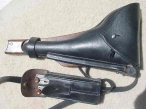
upload photo | donate | calendar
 |
my profile |
register |
faq |
search upload photo | donate | calendar |
|
|
#14 |
|
Moderator
Lifetime Forum Patron Join Date: Jun 2002
Location: Arizona/Colorado
Posts: 7,775
Thanks: 4,995
Thanked 3,133 Times in 1,439 Posts
|
Cpwlew, The excess is removed with a putty knife. Pecard's is primarily a petroleum wax from what I have seen and to soak it all in, it would be necessary to heat the holster to damaging temperatures.
I must agree with my former Brother in arms, Tom Armstrong. Pecard's is just so much petroleum goo. It does not soak in but leaves a waxy sticky surface that collects dust, dirt and flying insects like the La Bria Tar pits. As Lonnie says, use it sparingly... I have seen holsters sent to me for repair where the owner has used Pecard's very lightly and it did not seem too objectionable. I still do not like the stuff for preserving old leather. Pete is right about the toothbrush on the stitching. Use a soft one and be careful not to brush too hard. Linen thread used to build these is a plant fiber and can become soft and fragile, suceptable to damage by abraision.Try to brush with the lines of thread, not accross them. Also any substance you put on the holster can soak into this dry thread and once on it is impossible to get it off. That's why some leather experts advise that you use nothing on old leather. Often any cream applied can cause the surface to seperate from the under layer where it is cracked. Sort of like icing between two layers of cake, it becomes slippery. Then you begin to notice pieces flaking off. The best defence against deterioration is proper storage . Do not lay anything on top of your holsters. Fill out their form with an acid free paper wadded up to keep them in shape. Do not overstuff them as it might stretch and crack the leather and it's surface.Inspect the leather carefully to determine it's pliability. Be careful of the lifting strap when doing this, you could easily break it loose from it's moorings and tear it out. Keep them in low light and low humidity. Or at least try to keep the humidity as low as possible. Put a small roll of acid free paper in the top of the belt loops to keep their shape. I store my holsters in flat plastic boxes with snap on lids. They can stack and are cheap to purchase. I use Connoly's Hide Food on any new leather item I make and I use it sparingly on old holsters if I think it might be of some help but to be honest I do not use any leather cream if I don't have too. The more I work with old leather the more experience I get and storage is the best key to preserving vintage holsters. For some it is too late. Almost no damage can be reversed, only stabalized. Tom mentions another topic of importance...Neats foot oil. It was developed to break down leather fibers on shoe soles and make the fibers slip and slide...it is an oil. This was to break in and waterproof stiff shoe soles that might last six months to a year and be discarded. IT IS DEATH TO VINTAGE HOLSTERS! If you have some in your cupboard, dispose of it. Good Luck! Jerry Burney
__________________
Jerry Burney 11491 S. Guadalupe Drive Yuma AZ 85367-6182 lugerholsterrepair@earthlink.net 928 342-7583 (CO & AZ) Year Round 719 207-3331 (cell)  "For those who Fight For It, Life has a flavor the protected will never know." |
|
|

|
| Thread Tools | |
| Display Modes | |
|
|